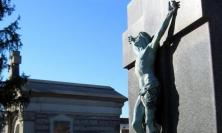In a new book, Irish Jesuit Gerry O’Hanlon looks at the difficulties currently facing the Church in Ireland. He suggests that the Church must find a new language through which it can engage honestly and positively in the public square. In an exclusive extract, he stresses the need to form the community of believers envisaged by the Second Vatican Council, so that all believers may find the courage and the means to respond to the challenges of faith.
The exclusion of religion from the public square – and, at the other extreme, religious fundamentalism – hinders an encounter between persons and their collaboration for the progress of humanity. (Pope Benedict XVI, Caritas in Veritate, 2009, n 56)
I was in Naples, visiting friends. It happened to be September 19, feast of San Gennaro, martyred in 305 and patron saint of the city. My friends suggested I attend the ceremonies in the Cathedral marking the occasion.
I had often heard about the legend of this saint: how, it was claimed, after his violent death some of his blood had been gathered by a pious lady called Eusebia, how it was held now in a sacred container in a side altar of the Duomo (the Cathedral), and how on his feast day it was supposed to liquefy – a sign of grace not just for the Catholics, but for the whole city of Naples, so that believers and unbelievers alike (even the Communists of yester-year) looked to this sign each year. To be truthful, I had often chuckled about all this, pulling the legs of my friends: surely no educated person believed in this kind of superstition any more?
And yet here I was, at 7.30 on that Friday morning, making my way down a street narrower than Henry Street in Dublin, but with stall holders selling wares on either side, towards the Duomo. A big crowd, growing. An air of anticipation. A dodgy enough part of the city, home to, among others, the Camorra, the ruthlessly violent Neapolitan version of the Mafia.
Inside the vast Cathedral, several times the size of Gardiner Street Church in Dublin but with the same Baroque decoration, the atmosphere was reverent and recollected. A concelebrated Mass began. Afterwards a rosary, with seemingly endless trimmings, was recited. By now, one and a half hours in, the Cathedral was full, and the atmosphere became more intense. There was a burst of applause as a procession of dignitaries, civil and ecclesiastical, assembled, flanked by colourfully dressed soldiers and police: the Governor, the Mayor, civic officials, priests, bishops, and, in the middle of them all, Cardinal Sepe, the Archbishop of Naples. They processed to the side-altar: the container with the blood was retrieved from the safe and held aloft in procession towards the main altar. Behind, on a kind of stretcher, was a gold effigy of Gennaro. The crowd clapped loudly.
The Cardinal addressed us from the main altar: ‘Fratelli, sorelle (brothers and sisters), I have good news: the blood has liquefied!’ Thunderous applause, some shouts, tears, white bandannas waved. Then, after two readings from Scripture, the Cardinal began to speak…
And this was the truly marvelous, miraculous thing – what he said, in that heightened context. He said how wonderful it was that once again our city has been given a sign of God’s love…but this kind of sign is less important than being a good Christian, a good citizen…facing up to the violence of the Camorra (‘those poisonous serpents’, he called them)…putting the poor in the first place, doing away with the privileges of the rich…looking after the homeless…giving hope to young people, who are often confused…looking after those elderly who are isolated…engaging in inter-religious dialogue in order to bring peace and understanding among religions: in short, putting social justice and good citizenship at the heart of the Christian response to the enormous love of God shown to the people of Naples by, among other things, this sign of the liquefied blood.
What Cardinal Sepe had done was to bring the voice of religion into the public square. Drawing on popular devotion, but also on the human and political situation of the city at the time, he succeeded in speaking a word of hope that inspired and motivated citizens. He did so by reference to the transcendent God, within whose care we are all treasured, and who is the basis and guarantor of all our thirst for justice and human rights. He did so by reference to the broken and risen figure of Jesus Christ, the immanence of divine presence, whose intimate identification with humanity allows us to look evil and failure in the eye. The Cardinal intimated how the following of Jesus enabled us to continue the ‘long march’ through our societal and political institutions, in resolute search of anticipations now of that Kingdom of God, which will come in its fullness at the end of time. He spoke in a way that made it clear to the people of Naples that, look, all kinds of extraordinary things can happen, but the important miracles are those that happen in ordinary life, when, like Jesus, we manage to get it right about being human.
Of course Naples is not London, Edinburgh, Cardiff or Dublin. We need to find our own idiom in our own region to allow the voice of faith to be heard in our public squares. This is not easy at a time when there is a concerted attempt to relegate religion to the harmless sidelines of what is private and personal. This is a long-held view of different strands of Modernity, exacerbated now by the hostility of New Atheism and the perhaps more insidious cultural immanentism identified by Charles Taylor. Breathing this cultural air we experience not so much a rational denial of God as a more moral sensibility, a common sense bias in Lonergan’s terminology, which has persuaded itself that human flourishing is intrinsically immanent. This secularist position has only been reinforced by reaction to the emergence of aggressive forms of fundamentalist Islam, with explicit political agendas.
In the particular case of Ireland, the search for an appropriate idiom to allow the religious voice to be heard in the public square needs to take account of several factors specific to our local situation. In truth, the Ireland of today would not seem to provide fertile soil for public theological debate. The grip of the Church in the past has been too oppressive, there has been little respect within the Church itself for theological thinking, and the public intellectual culture has been negatively affected by the relative absence of Catholic theology at university level. This negative context has been immeasurably reinforced by the scandal of clerical child sexual abuse and its mishandling by Church authorities, as evidenced in the Ferns, Ryan and Murphy Reports. These scandals have revealed a clericalist culture of secrecy, denial and privileging of the reputation of the Church over more basic matters of right and wrong – the ‘don’t ask, don’t tell’ culture to which Murphy refers.
In this context we have long gone past the time when the Church in Ireland can teach in a declamatory way, resting its case on its own moral authority. Instead we need to find a new language of dialogue and persuasion, one which is able to discern in secularisation the blessed intimations of the Holy Spirit as well as the inevitable traces of the Evil Spirit; one, in short, which knows really, and not just in a politically correct way, that we as Church have a lot to learn from the ‘world’ as well as much to teach it. We need to develop the kind of idiom of plausibility in which the hypothesis of God and Jesus can resonate with the lived experience of our citizens in a way which inspires and motivates. We need to engage in a conversation which avoids any simplistic immediacy in the application of Gospel insights to complex human situations. Instead we must undertake that mediated search for meaning which is respectful of human experience and which engages in serious dialogue with other academic disciplines, all the time acknowledging their rightful autonomy.
We will be helped in our search for this new language if the body to which we belong, the Church, can find the grace to tackle the institutional dysfunctionality that the crisis has revealed, not just in Ireland, but universally. We need a reconsideration of the ecclesiology of Vatican II. In it, the most authoritative statement of faith concerning the Church that we have in modern times, priority is given to the People of God, whose ‘sense of the faith’ becomes a source of truth and decision. The hierarchy – Pope, bishops and priests – are to exercise their authority in service of the baptised People of God.
The ‘miracle’ that we need in these days, the grace that we can be sure that God wishes to grant us, is the realisation of that communio, that communion among believers which Vatican II spoke about. In this communion Catholics may search for God’s way into the future as a group of equals, adults, even within that difference of function which the service of authority recommends.
The distinguished Jesuit canonist Ladislas Orsy has a proposal in this regard: ‘Whereas the years from 2012 through 2015 will be the fiftieth anniversaries of the Council, they should be solemnly declared the years of the Council –when the entire people, “from the bishops to the last of the faithful” (Lumen Gentium, 12, quoting St Augustine), recalls the memory of the “Sacred Council” (SC 1), studies its determination, and exposes itself to the transforming light and force of the Spirit – as the Council Fathers did’. (L. Orsy, Receiving the Council, Minnesota: Glazier, 2010, p 152) It is a proposal which might, I suggest, be taken up with profit not just in Ireland but throughout our Catholic Church.
Of course a reformed Church would be a great boon in our efforts to find an effective voice in the public square. But in the meantime, with all its drawbacks – not least that ‘dictatorship of relativism’ which does scant justice to reasoned conversation – the culture of Post Modernity has opened the public forum to alternative voices and to a notion of rationality which transcends the merely empirical and scientific. And so, even now, we can be bolder in our articulation of those ‘rumours of angels’ to which Berger referred a long time ago. If we do so, in Ireland and elsewhere too, from a position of some embarrassment and even shame in our present context, then perhaps this place of humiliation and truth is not the worst starting point for people who want to tell about the folly of the Cross, the story of Jesus who emptied himself.
We will need imagination and creativity, as well as hard thinking and not a little courage, to discover the idiom which allows our voices to be heard again in the public square. But, like the two disciples on the way to Emmaus, our world has great need, on so many fronts, to understand that all is not as it seems, that ‘all will be well’. When Jesus has told us that he has come to bring us all life, to the full, how can we remain silent, how can we do less than try to find good ways of entering the public square with the ‘full hand’ of faith?
Gerry O’Hanlon SJ is Associate Professor of Systematic Theology at the Milltown Institute and staff member of the Jesuit Centre for Faith and Justice in Dublin.
This article is based on extracts from his recent publication, Theology in the Irish Public Square (Dublin: Columba Press, 2010), available at www.columba.ie
![]() Theology in the Irish Public Square
Theology in the Irish Public Square
![]() Jesuit Centre for Faith and Justice
Jesuit Centre for Faith and Justice






